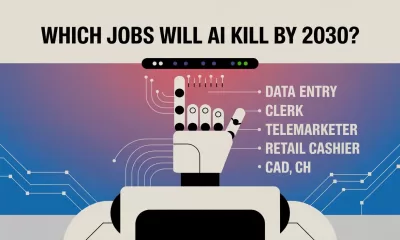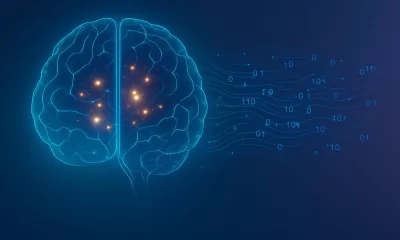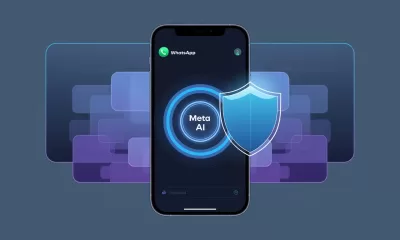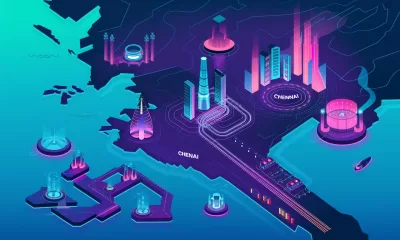Life
Predicting Fetal Well-being with Deep Learning
AI fetal monitoring using deep learning models for CTG interpretation improves neonatal outcomes and reduces provider burden.
Published
7 months agoon
By
AIinAsia
TL;DR:
- AI models can predict fetal well-being using cardiotocography (CTG) signals.
- Deep learning methods improve CTG interpretation, reducing false-positive rates.
- Combining fetal heart rate (FHR) and uterine contractions (UC) data enhances model performance.
The Future of Fetal Monitoring
Imagine a world where artificial intelligence (AI) can accurately predict the well-being of a fetus during pregnancy and labour. This is no longer a dream; it’s a reality. Recent advancements in AI and deep learning are revolutionising the field of fetal monitoring, offering the potential to improve neonatal outcomes and reduce the burden on healthcare providers. In this article, we delve into the groundbreaking work on developing and evaluating machine learning models for cardiotocography (CTG) interpretation.
Understanding Cardiotocography (CTG)
Cardiotocography (CTG) is a crucial technique used during pregnancy and labour to monitor fetal well-being. It involves recording the fetal heart rate (FHR) and uterine contractions (UC) using doppler ultrasound. CTG can be done continuously or intermittently, with sensors placed externally or internally.
Currently, healthcare providers interpret CTG recordings using guidelines from organisations like the National Institute of Child Health and Human Development (NICHD) or the International Federation of Gynecologists and Obstetricians (FIGO). These guidelines define patterns in CTG and FHR traces that may indicate fetal distress.
The Role of AI in Improving CTG Interpretation
Despite its widespread use, CTG interpretation is complex and subjective, leading to high false-positive rates and intra- and inter-observer variability. This is particularly challenging in low-resource settings where access to skilled interpreters is limited.
Enter AI. Recent research has focused on using deep learning methods to improve CTG interpretation. These methods use physiological time series data as input, offering a more comprehensive analysis compared to traditional feature extraction techniques.
Developing and Evaluating Deep Learning Models for CTG
In a recent paper titled “Development and evaluation of deep learning models for cardiotocography interpretation,” researchers developed end-to-end neural network-based models to predict measures of fetal well-being. These models were trained on an open-source CTG dataset, the CTU-UHB Intrapartum Cardiotocography Database, which includes 552 FHR and UC CTG signal pairs.
Model Architecture
The researchers began with the CTG-net network architecture, which convolves the paired FHR and UC input signals temporally before conducting a depthwise convolution to learn the relationship between them. They added several methodological configurations, including architecture and hyperparameter optimization, single input variation, and the addition of clinical metadata.
Pre-processing and Pre-training
To improve data quality, the researchers created a pre-processing pipeline that included inputting missing measurements, random cropping, and additive multiscale noise for data augmentation and downsampling. This generated a large dataset for pre-training and training the models.
Intermittent versus Continuous CTG Use Cases
CTG use comes in two primary formats: intermittent and continuous. In high-resource settings, continuous CTGs are used to monitor fetal heart rate throughout labour. In low-resource settings, intermittent CTGs are often used, covering only about 30 minutes at any point during labour.
The researchers simulated intermittent settings by splitting the 90-minute signals in the dataset into 30-minute signals and training and evaluating the model at different time points. This helped understand how training and evaluating on intermittent time points impacts model performance.
Predicting Objective and Subjective Ground Truth Labels
The researchers used three outcome labels from the dataset:
- Arterial umbilical cord blood pH: An objective measurement that tracks fetal acidosis, an indication of fetal distress.
- Apgar score: A subjective measure recorded by a clinician after delivery that reflects the general health of the newborn.
- Abnormal label: If either Apgar or pH results were abnormal.
Evaluating Model Prediction Robustness
The researchers performed several comparisons to evaluate model performance, including:
- Performance on the dataset versus the state-of-the-art CTG-net model.
- Apgar versus pH classification tasks.
- FHR-only versus FHR+UC.
- Base model using the last 30 minutes of labour (continuous case) versus intermittent measurements.
- Base model of FHR+UC versus FHR+UC+Metadata.
- Subgroup performance of the base model (FHR+UC) with subgroups determined by binarizing clinical metadata.
The results showed that combining FHR+UC achieved the highest model performance for both pH and Apgar classification. The pre-training step enabled the highest model performance, and adding clinical metadata slightly improved model performance for pH but less so for Apgar.
Subgroup Evaluations
The researchers found significant differences in baseline performance between subgroups with frequent and infrequent UC signals gaps for pH prediction and for subgroups with frequent and infrequent FHR signal gaps for Apgar prediction. With metadata, the performance disparities observed with pH prediction were mitigated. However, including metadata increased the AUROC performance disparities for demographic and clinical-related subgroups on this task.
Open CTG Model for Research Use Cases
The researchers are currently exploring open-sourcing their models, hoping that other researchers and stakeholders can build on this work with their own datasets to evaluate it for their clinical use cases.
Limitations and Future Work
The study had limitations that constrain the generalizability of the findings. Future investigations should involve a larger and more diverse dataset sourced from maternity centers worldwide, encompassing varied clinical contexts, demographics, and outcomes. Additionally, further work is needed to understand how such prediction algorithms can be optimally integrated into clinical workflows to improve neonatal outcomes.
The Promise of AI in Fetal Monitoring
The development and evaluation of deep learning models for CTG interpretation hold immense promise for improving fetal monitoring and neonatal outcomes. By leveraging AI, healthcare providers can gain objective interpretation assistance, reducing the burden and potentially improving fetal outcomes.
Comment and Share:
What are your thoughts on the future of AI in fetal monitoring? Do you think AI can revolutionise the field and improve neonatal outcomes? Share your experiences and thoughts in the comments below. Don’t forget to subscribe for updates on AI and AGI developments and join the conversation!
- You may also like:
- AI Takes Aim at Skin Cancer: DermaSensor Gets FDA Nod
- How AI and Wearables are Transforming Medicine
- Revolutionising Healthcare: Malaysia’s First AI-Detected Lung Cancer Success Story
- To learn more about AI and fetal medicine, tap here.
Author
Discover more from AIinASIA
Subscribe to get the latest posts sent to your email.
Life
WhatsApp Confirms How To Block Meta AI From Your Chats
Perplexity CEO Aravind Srinivas is battling Google, partnering with Motorola, and launching a bold new AI browser. Discover why the fight for the future of browsing is just getting started.
Published
1 day agoon
April 28, 2025By
AIinAsia
TL;DR — What You Need To Know
- Meta AI can’t be fully removed from WhatsApp, but you can block it on a chat-by-chat basis.
- “Advanced Chat Privacy” is a new feature that prevents Meta AI from accessing chat content, exporting chats, or auto-saving media.
- Enable it manually by tapping the chat name, selecting Advanced Chat Privacy, and switching it on for greater control.
Meta and Google are racing to integrate AI deeper into their platforms—but at what cost to user trust?
While Google has been careful to offer opt-outs, Meta has taken a much bolder route with WhatsApp: AI is simply there. You can’t remove the little blue Meta AI circle from your app. If you don’t like it, tough luck. Or is it?
Facing backlash from frustrated users, WhatsApp has now quietly confirmed that you can block Meta AI from your chats—just not in the way you might expect.
The Rise of AI — and the Pushback
When the unmissable Meta AI blue circle suddenly appeared on billions of phones, the backlash was immediate. As Polly Hudson put it in The Guardian, there are “only two stages of discovering the little Meta AI circle on your WhatsApp screen. Fear, then fury.”
Meta’s public stance? “The circle’s just there. But hey, you don’t have to click it.” Users weren’t impressed.
Despite WhatsApp’s heritage as the world’s largest private messaging app—built on privacy, security, and simplicity—its parent company is a marketing machine. And when marketing meets AI, user data tends to be part of the mix.
This left WhatsApp’s loyal user base feeling understandably betrayed.
The Good News: You Can Block Meta AI — Here’s How
Although the Meta AI button is baked into WhatsApp’s interface, you can stop it from accessing your chats.
The Advanced Chat Privacy feature quietly rolled out in the latest WhatsApp update allows users to:
- Block AI access to chat content.
- Prevent chats from being exported.
- Stop media auto-downloads into phone galleries.
“When the setting is on, you can block others from exporting chats, auto-downloading media to their phone, and using messages for AI features,” WhatsApp explains.
Crucially, this also means Meta AI won’t use the chat content to “offer relevant responses”—because it won’t have access at all.
How to activate Advanced Chat Privacy:
- Open a chat (individual or group).
- Tap the chat name at the top.
- Select ‘Advanced Chat Privacy.’
- Turn the feature ON.
That’s it. Blue circle neutralised—at least inside those protected chats.
Why This Matters
Even though Meta claims it can’t see the contents of your chats, the small print raises concerns. When you interact with Meta AI, WhatsApp says it “shares information with select partners” to enhance the AI’s responses.
The warning is clear:
“Don’t share information, including sensitive topics, about others or yourself that you don’t want the AI to retain and use.”
That’s a pretty stark reminder that perception and reality often differ when it comes to data privacy.
Final Thoughts
WhatsApp’s Advanced Chat Privacy is a clever compromise—it gives users real control without allowing them to remove AI entirely.
If privacy matters to you, it’s worth spending a few minutes locking down your most important chats. Until Meta offers a more upfront opt-out—or until regulators force one—this is the best way to keep Meta AI firmly outside your private conversations.
What do YOU think?
Should AI features in private apps be opt-in by default—or are platforms right to assume “engagement first, privacy later”? Let us know in the comments below.
You may also like:
- AI-Powered Photo Editing Features Take Over WhatsApp
- Meta Expands AI Chatbot to India and Africa
- Revamping Your Samsung Galaxy: AI Advancements for Older Models Unveiled
- Or you can try Meta AI for free by tapping here.
Author
Discover more from AIinASIA
Subscribe to get the latest posts sent to your email.
Life
AI Career Guide: Land Your Next Job with Our AI Playbook
Discover how to leverage AI for your career success. Our AI career guide offers tips on CV writing and interview preparation.
Published
3 weeks agoon
April 10, 2025By
AIinAsia
- AI transforms every step of your job hunt.
- From CV writing to interview prep—turning a stressful, uncertain process into strategic clarity.
- While AI won’t directly secure you a job, it will significantly boost your chances.
- Welcome to Your AI Career Playbook.
Introduction: Making AI Your Personal Career Coach
Let’s be honest: finding a great job in Singapore—or anywhere in Asia—is no cakewalk. The market moves quickly, employers want more specialised skills than ever, and getting your CV past automated scanners feels like navigating a digital minefield.
What if you had an always-on career advisor that could help you write perfect applications, prep you for interviews, and even help you network? It’s not a fantasy—it’s artificial intelligence. AI tools are now sophisticated enough to give you the career edge you need. By the end of this guide, you’ll have a clear playbook for harnessing AI to land your next big role.
Let’s dive in!
Can AI Actually Land You Your Next Job—or is That Just Hype?
Let’s get real: AI isn’t about replacing your effort, but about amplifying your abilities. With AI, you can:
- Craft a customised, keyword-rich CV that sails through Applicant Tracking Systems (ATS).
- Optimise your LinkedIn profile instantly for maximum visibility.
- Identify emerging AI-driven job roles and skills employers actually care about.
- Anticipate and ace your interviews using AI-generated questions and answers.
AI doesn’t just automate tedious tasks; it empowers you to compete smarter, especially in competitive markets like Singapore, Jakarta, or Hong Kong.
AI-Powered Career Prep: Step-by-Step Playbook
Here’s a comprehensive guide to turbocharging your career search using AI, including practical examples, recommended tools, and easy-to-use prompts.
Step 1: Crafting an Irresistible CV with AI
Your CV typically has less than 10 seconds to impress a recruiter. It must pass through Applicant Tracking Systems (ATS) before it ever reaches human eyes. AI tools can optimise your CV to ensure it’s keyword-rich, tailored precisely to each role, and visually appealing.
AI Tools to Use:
- ChatGPT (OpenAI) – powerful generative AI for rewriting CVs.
- Kickresume AI – professional CV builder with AI-driven wording suggestions.
- TealHQ – provides ATS-friendly formatting and skill recommendations.
How to Use These Tools:
- Input your current CV.
- Use targeted prompts to optimise content.
Prompt Examples:
Rewrite my CV to highlight experience in AI-driven marketing analytics for a senior digital strategist role at DBS Bank in Singapore.
Optimise my CV for ATS, targeting a software engineering position specialising in AI at Grab.
Spend time refining outputs; personalisation is essential.
Step 2: Supercharging Your LinkedIn Profile with AI
LinkedIn is your professional showcase. Recruiters across Asia heavily rely on LinkedIn to discover and vet candidates. AI tools can instantly elevate your profile, making it searchable, engaging, and compelling.
AI Tools to Use:
- Taplio – LinkedIn profile optimiser powered by AI.
- LinkedIn’s built-in AI assistant – available in LinkedIn Premium for profile enhancement.
- Jasper.ai – excellent for creating engaging summaries and posts.
Prompts to Try:
Write a compelling LinkedIn headline showcasing my expertise in AI-driven fintech analytics for a managerial role in Singapore.
Create an engaging LinkedIn ‘About’ section focusing on my success using AI to drive digital transformation in APAC.
Make sure your profile authentically reflects you while leveraging AI-generated enhancements for maximum impact.
Step 3: AI-Driven Job Hunting: Find Perfect Roles Faster
Stop endlessly scrolling through vague job ads. AI can streamline the job search, filtering through thousands of postings and pinpointing roles perfectly matched to your skills.
AI Tools to Use:
Google’s Gemini – summarise key job requirements rapidly.
Effective Prompts:
Find and summarise 5 recent AI-related digital marketing job openings in Singapore that match my profile.
What are three critical skills needed for a senior data analyst role at Shopee based on recent job postings?
Use these AI tools weekly to ensure you’re always applying to roles most aligned with your skills.
Step 4: Effortless Networking Using AI
Networking remains essential, especially in relationship-focused business cultures like Singapore and Hong Kong. AI takes away the awkwardness, helping you craft concise, professional messages instantly.
AI Tools to Use:
- Crystal – personality-driven messaging based on recipients’ LinkedIn profiles.
- Lavender.ai – powerful for writing persuasive cold emails.
- GrammarlyGO – ensures your messages are polished and professional.
Prompt Ideas:
Draft a LinkedIn connection message for the Head of AI at SQREEM Technologies, highlighting my interest in AI-driven advertising solutions.
Compose a brief, engaging introductory email to the talent acquisition manager at TotallyAwesome, mentioning my expertise in digital marketing for youth brands.
Leverage these messages for immediate relationship-building impact.
Step 5: Acing Interviews with AI-Powered Preparation
AI tools can simulate real-world interviews, predicting specific questions and generating strong, persuasive answers, greatly increasing your interview confidence.
AI Tools to Use:
- ChatGPT – instantly creates practice questions and tailored responses.
Example Prompts:
List 10 likely interview questions for an AI product management role at Carousell, including challenging technical questions.
Suggest impactful answers for behavioural interview questions for a senior analytics role at Lazada.
How to Use These Tools:
- Input the job description and your CV.
- Practise with AI-generated questions and refine your answers.
Example Prompt:
List 10 likely interview questions for an AI product management role at Carousell.
Regular AI-driven interview rehearsals build the confidence you’ll need on interview day.
Step 6: AI-Assisted Salary Negotiation
Negotiating your salary can be uncomfortable—but essential for your financial growth. AI can provide you with the insights, confidence, and language to secure the best possible offer without feeling awkward.
AI Tools to Use:
- Payscale – Uses AI-driven data to show accurate salary benchmarks.
- Levels.fyi – AI-backed salary comparisons across tech roles globally.
- ChatGPT – Assists with crafting persuasive negotiation dialogues.
How to Use These Tools:
- Check salary ranges based on role, location, and experience.
- Prepare negotiation talking points with AI-generated prompts.
Prompt Examples:
Suggest three effective negotiation arguments to present to my employer for an AI Product Manager position in Singapore, considering current market salaries.
Write a polite but firm salary negotiation email asking for a 15% increase based on market research and my experience in AI analytics.
This ensures you approach negotiations informed, confident, and professionally.
Step 7: Perfect Follow-Up Emails Using AI
A timely, thoughtful follow-up email can significantly impact hiring decisions. AI helps craft follow-ups that reinforce your suitability without sounding desperate.
AI Tools to Use:
- GrammarlyGO – refines your professional tone.
Prompt Example:
Write a professional, concise follow-up email thanking the interviewer from DBS Bank Singapore, reiterating my strong interest and qualifications for the AI analyst position.
Send promptly post-interview to leave a memorable impression.
Step 8: AI-Enhanced Skills Development and Certification
Continual skill development is vital to stay competitive, especially in AI-centric roles. AI-driven platforms help you identify skill gaps and recommend tailored courses to keep your expertise sharp and attractive to employers.
AI Tools to Use:
- Coursera Skillsets – Personalised AI-based learning path recommendations.
- LinkedIn Learning – AI-driven recommendations based on your professional profile.
How to Use These Tools:
- Provide your career interests and existing skills.
- Receive personalised course recommendations to bridge gaps effectively.
Prompt Examples:
Suggest 3 online certifications or short courses that will significantly enhance my profile for a career as an AI-driven data analyst in Singapore.
Identify 5 trending AI-related skills I should learn in 2025 to be highly competitive in the fintech sector.
Consistent skill updates significantly enhance your marketability.
Step 9: Using AI to Monitor Your Professional Brand
Your personal brand matters—especially when employers frequently vet online profiles. AI tools proactively monitor your digital footprint, ensuring your online reputation supports your professional goals.
AI Tools to Use:
- BrandYourself – AI-driven online reputation management.
- Mention.com – Monitors your digital presence and mentions using AI.
- Google Alerts – AI-enhanced alerts about new online mentions.
How to Use These Tools:
- Set up AI-driven alerts for your name, profession, and industry keywords.
- Regularly review insights to maintain or enhance your professional online image.
Prompt Examples:
How can I optimise my online professional presence to appeal to recruiters in AI-driven roles in Singapore?
Suggest effective strategies to build a strong online reputation as an expert in AI analytics.
An AI-supported professional brand ensures you stay attractive to prospective employers.
Step 10: AI-Powered Job Application Tracking and Organisation
Keeping track of multiple job applications can quickly become overwhelming. AI-powered organisational tools streamline and manage this complexity, giving you clear visibility at every stage of your job hunt.
AI Tools to Use:
- Huntr – Tracks your job application pipeline with AI insights.
- Notion AI – Customisable database and AI-powered task management.
How to Use These Tools:
- Enter job details, deadlines, and application status into your chosen tool.
- Use automated reminders to follow up on applications and interviews.
Prompt Examples:
Provide a clear workflow for organising job applications and interview follow-ups using Notion AI.
Recommend the best ways to stay organised and effective while managing multiple job applications simultaneously.
Organisation is crucial—let AI keep your job hunt stress-free and systematic.
Step 11: AI-Enhanced Mental Wellbeing During Your Job Hunt
Job hunting is stressful. Maintaining your mental health is critical to your productivity and confidence. AI-based wellness apps provide personalised strategies to help manage stress effectively during your career transition.
AI Tools to Use:
- Headspace (AI-driven wellness plans) – Personalised meditation and mindfulness guidance.
- Wysa – AI chatbot providing emotional support and stress management.
How to Use These Tools:
- Regularly engage with AI-driven mental wellness apps.
- Practise stress management techniques specifically designed for career transitions.
Prompt Examples:
Suggest effective strategies for managing job-hunting anxiety, particularly related to AI and tech career transitions.
What are daily habits I can implement using AI-driven tools to maintain positivity during an extended job search?
Maintaining your mental wellbeing boosts your overall effectiveness and resilience.
Step 12: AI-Powered Career Pivot Planning
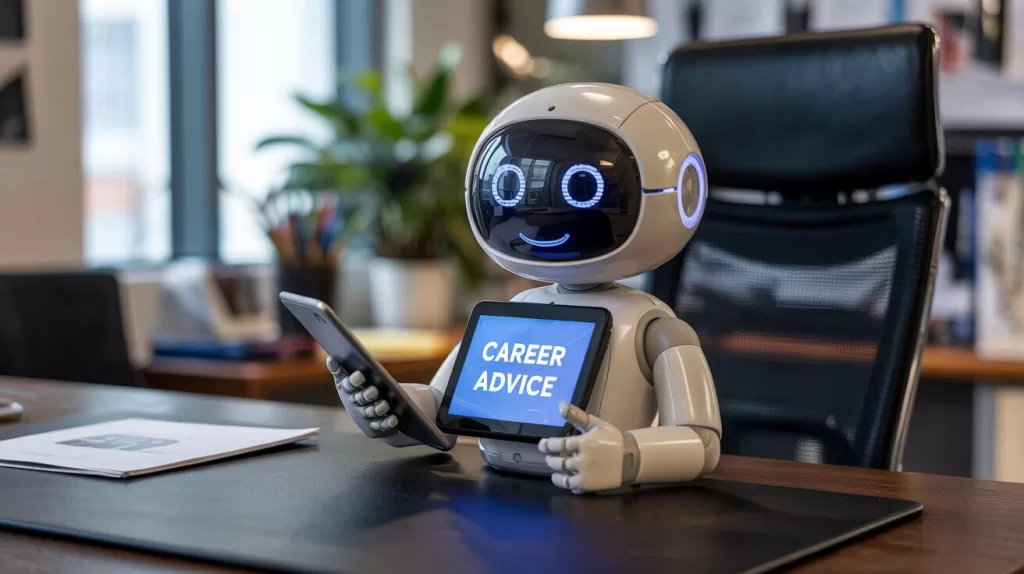
Considering a career pivot? AI can assist you by identifying transferable skills, suggesting appropriate new career paths, and crafting narratives that effectively communicate your value to recruiters.
AI Tools to Use:
- CareerExplorer – AI-driven insights to match your skills to new career options.
- FutureFit.AI – Career-pivot-focused AI insights.
How to Use These Tools:
- Enter your current experience, interests, and skills.
- Review AI-generated career pivot recommendations and plan next steps.
Prompt Examples:
Identify three alternative career paths suitable for someone with extensive marketing experience transitioning into AI-centric roles.
Write a persuasive personal statement for my CV explaining a career pivot from traditional banking to fintech and AI analytics.
AI can help make career transitions smoother, clearer, and more achievable.
Bonus Steps
1. AI-Powered Portfolio and Project Showcases
- Candidates increasingly require impressive online portfolios—especially crucial for creative, tech, or analytical roles.
- Tools:
- Canva AI (design-focused portfolios)
2. AI-Enhanced Video Interviewing
- Many companies now rely on AI-driven video interviews. Your readers should prepare specifically for this format.
- Tools:
- HireVue (AI-powered video interview practice)
3. AI-Driven Cover Letter Crafting
- Despite modern scepticism, cover letters still matter—especially for senior roles or competitive companies.
- Tools:
- ChatGPT (custom letter generation)
5 AI Mistakes to Avoid in Your Job Hunt
AI is powerful—but watch out for these pitfalls:
- Overreliance on AI: Always personalise AI-generated content.
- Ignoring Cultural Context: Ensure your prompts consider Asia-specific nuances.
- Copy-Paste Syndrome: Adapt AI outputs rather than copying verbatim.
- Privacy Negligence: Avoid sharing personal data with unsecured AI services.
- Accuracy Oversights: Always fact-check AI suggestions.
So, can AI actually land you your next job—or is that just hype?
The reality is nuanced. AI itself doesn’t offer job contracts—but it dramatically enhances every step of your job-seeking process. From perfecting your CV to providing negotiation insights, AI maximises your chances of landing your ideal role.
Take Action & Share Your Experience:
Have you tried these steps or prompts? Which AI tools worked best for you? Share your experience below—we’d love to hear your AI-powered job success stories!
Good luck, and happy AI-powered job hunting!
You may also like:
- How to Use ChatGPT
- How to Use ChatGPT and Impress Hiring Managers
- AI to the Rescue: Mastering Your LinkedIn Profile with ChatGPT
Author
Discover more from AIinASIA
Subscribe to get the latest posts sent to your email.
Life
Which Jobs Will AI Kill by 2030? New WEF Report Reveals All
Cashiers and postal worker jobs will disappear by 2030 as AI reshapes jobs globally. Which roles vanish and who’ll thrive, according to WEF
Published
3 weeks agoon
April 7, 2025By
AIinAsia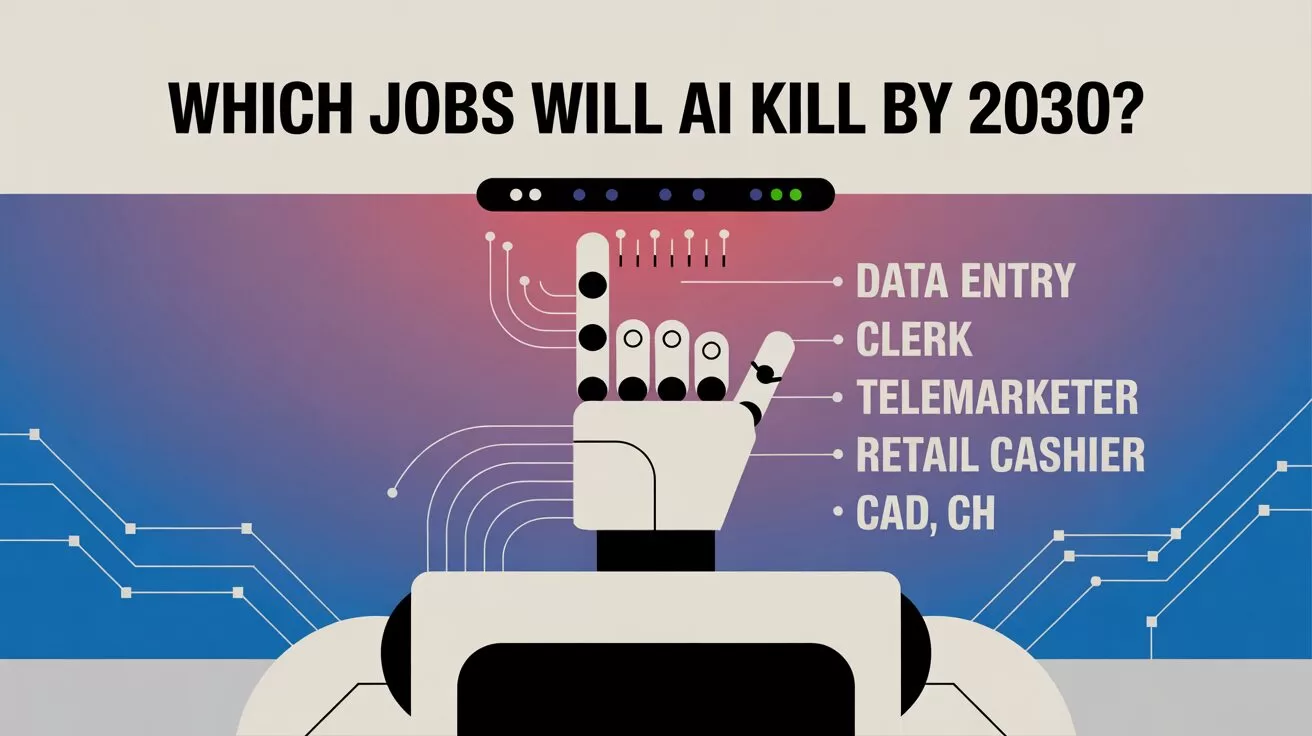
TL;DR – What You Need to Know in 30 Seconds
- Jobs on the chopping block: cashiers, postal workers, bank tellers, and admin assistants.
- Booming sectors: delivery, construction, tech, green industries, and caregiving.
- Skills employers crave: critical thinking, AI literacy, cybersecurity, and adaptability.
Is Your Job AI-Proof—Or Set to Vanish By 2030?
It’s official: AI is coming for your job. Okay, perhaps that’s a touch dramatic—but according to a startling new report from the World Economic Forum (WEF), some careers we currently take for granted will practically disappear by 2030.
Let’s be honest—this isn’t exactly surprising. Technology moves fast. AI tools like ChatGPT, automated kiosks, and smart banking apps already handle tasks that used to need humans. So, which roles are most at risk, and what new opportunities will emerge? Let’s dive into the findings.
Goodbye cashiers and postal clerks?
Top of the endangered list are clerical jobs. Cashiers, bank tellers, postal clerks, and admin assistants—these roles are shrinking fast as automation takes over repetitive tasks. The reason is clear: if a machine can handle your job quicker, cheaper, and 24/7, companies will switch.
Globally, the WEF estimates 92 million jobs will vanish by 2030. That sounds worrying, but there’s a silver lining—170 million new jobs will be created, meaning a net gain of 78 million jobs overall. But the catch? You’ll likely need new skills.
Which jobs will thrive in an AI world?
So, who’s safe (for now)? According to the WEF, frontline workers will be in huge demand. Expect growth in sectors such as:
- Delivery drivers (all those parcels from Lazada and Shopee won’t deliver themselves!)
- Construction workers (someone has to build those skyscrapers and infrastructure projects)
- Care workers and nurses (robots still can’t quite replicate human empathy)
- Teachers and counsellors (because education and mental health matter more than ever)
- Food-processing workers and farmworkers (we still need food, and lots of it)
Surprisingly human stuff, isn’t it?
And of course, the tech sector is set to boom. AI specialists, big data experts, fintech engineers, and software developers will be among the highest-growth roles by percentage. Green jobs—like renewable energy engineers and electric vehicle specialists—are also taking off, driven by the urgent need for sustainability.
Skills employers are desperate for
So, what do employers actually want? AI is reshaping job descriptions, and with that comes demand for a new mix of skills.
While tech skills like AI literacy, cybersecurity, and big data analytics are essential, companies also crave distinctly human skills: analytical thinking, resilience, agility, and creativity. Critical thinking tops the list—with 70% of companies calling it essential. It seems robots aren’t quite ready to think for themselves (yet).
Interestingly, workers can expect almost 40% of their existing skills to become outdated or radically altered within the next five years. The good news? The speed of this disruption is slowing down compared to previous years—likely because workers are proactively upskilling, embracing new tech, and keeping pace with change.
So, what’s next?
AI won’t wipe out all jobs, but it will reshape nearly all of them. The message is clear: get ready to learn. The real difference-maker for your career won’t just be your skills—it’s how quickly you can adapt to changes that technology brings.
So, ask yourself: are you ready to pivot? Because your job might depend on it.
What do you think—are you worried or excited about AI’s impact on your career? Drop your thoughts below!
You may also like:
- How to Prepare for AI’s Impact on Your Job by 2030
- The AI Shift: Coping with AI Job Transformation in Asia
- Bridging the AI Skills Gap: Why Employers Must Step Up
- Young Workers are Embracing ChatGPT
- Read more at the official WEF website by tapping here.
Author
Discover more from AIinASIA
Subscribe to get the latest posts sent to your email.

When Did Chennai Become a Center for AI Innovation?

Meta’s AI Chatbots Under Fire: WSJ Investigation Exposes Safeguard Failures for Minors

WhatsApp Confirms How To Block Meta AI From Your Chats
Trending
-

 Life3 weeks ago
Life3 weeks agoWhich Jobs Will AI Kill by 2030? New WEF Report Reveals All
-

 Life3 weeks ago
Life3 weeks agoAI Career Guide: Land Your Next Job with Our AI Playbook
-

 Business1 day ago
Business1 day agoChatGPT Just Quietly Released “Memory with Search” – Here’s What You Need to Know
-

 Marketing5 days ago
Marketing5 days agoPlaybook: How to Use Ideogram.ai (no design skills required!)
-

 Life1 day ago
Life1 day agoWhatsApp Confirms How To Block Meta AI From Your Chats
-

 News10 hours ago
News10 hours agoMeta’s AI Chatbots Under Fire: WSJ Investigation Exposes Safeguard Failures for Minors
-

 Business1 hour ago
Business1 hour agoWhen Did Chennai Become a Center for AI Innovation?
-

 Business3 weeks ago
Business3 weeks agoWill AI Take Your Job—or Supercharge Your Career?









